7 Awesome Data Scientist Resumes [Tips & Templates]
![Awesome Data Scientist Resumes [+ Tips & Templates]](https://www.springboard.com/blog/wp-content/uploads/2018/06/awesome-data-scientist-resumes-tips-templates.png)
In this article

7.4 seconds. That’s how long, on average, a recruiter looks at a resume before making up their mind about a candidate. So, if you’re applying for a job, you have less than ten seconds to make a good impression. To do this, you need a clear, concise, specific, and impactful resume. In this blog post, we’ll walk you through how you can create that. We’ll explore why you need a strong resume, what you should include and what mistakes you avoid. We also offer examples and discuss some templates.
How Important is a Data Scientist Resume?
It is extremely important. The entry point to any position you want to be considered for is the data scientist resume. As the first step, organizations will expect applicants to submit a resume, cover letter, and portfolio. Without a strong resume, it would be impossible to even begin your job search. However, a data scientist resume can help you in a lot more ways than that.
Find the right role. Data science is a rapidly growing field. According to the U.S Bureau of Labor Statistics, opportunities in data science are expected to grow by about 28%—roughly 11.5 million new jobs will open in 2026. However, there is an evident supply gap. In 2020, they found there were three times more job postings than job searches in the field of data science. With the right resume, you can position yourself for jobs that are a perfect fit for your skills and experiences.
Make a great first impression. By customizing your resume for the role you are applying to, you can tell the hiring manager why you’re perfect for it. This will make a good first impression, setting you up for success in your interview.
Stand apart from the crowd. Recruiters skim through hundreds of resumes on any given day. With a clear and impactful data scientist resume, you can differentiate yourself from the crowd. By highlighting your unique combination of skills and experience, you can make an impression beyond the standard checklist of technical skills alone.
Drive the interview conversation. Hiring managers and interviewers often bring your resume to the interview, asking questions based on it. By including the right information in your resume, you can drive the conversation.
Negotiate competitive pay. While a resume might not have a direct impact on the pay, it plays the role of a single source of truth for your qualifications. By including all relevant skills and experience, you can make sure that the offer is reflective of your value to the employer.
What Should You Include in Your Data Science Resume?

In essence, your data science resume should effectively demonstrate why you are the perfect candidate for the role you’re applying to. So, the key element of deciding what to include in your resume is relevance: Include everything that is relevant to the role. In this section, we’ll discuss everything you can include in your data scientist resume.
Name and Contact Information
Once the recruiter has seen your resume and you’re shortlisted, they would want to contact you. To make this seamless, include your contact information clearly and prominently. But remember that this is simply functional information. So, keep it concise. Double-check that it’s accurate.
Include:
- Name
- Email ID
- Phone number
- LinkedIn, portfolio, or GitHub profiles, if any
Career Objective/Summary
This is often the first section in any resume. As a fresh graduate, without much professional experience, the career objective section acts as an indicator of what you would like to accomplish at the job you’re applying to. On the other hand, if you have some experience, it is better to include a personal profile, summarizing your skills and experiences.
A few things to keep in mind while writing your career objective/summary:
- Use this section to narrate your professional story, so paragraphs with complete sentences work better than a bulleted list
- Mention the years of experience you have
- Provide information on the industry, function, and roles you have worked in
While creating your resume, it is sometimes better to write this section last. Making the rest of your data scientist resume will help hone in on the right summary. Also, remember to customize your summary while applying for the job. Not all jobs are the same, so your summary should reflect what you can do for the particular role you’re applying to.
Work Experience
As a practical field, work experience is more important in data science jobs than theoretical knowledge. Therefore, this is the most crucial part of your resume.
If you are a fresh graduate, make sure to include any internships, personal projects, open-source contributions you might have.
If you’re an experienced data scientist, spend enough time to tell your professional story clearly:
- List your work experience in reverse chronological order, with the most recent work listed on top and the others following
- Indicate your designation, name of the company, and work period
- Write 1-2 lines about what you were responsible for
- Include the tasks you performed on a regular basis
- Demonstrate outcomes—if you have produced quantifiable results, be sure to include them. For instance: “I built a production prediction engine in Python page that helped reduce crude oil profit loss by 22%”
- Add accomplishments like awards and recognitions, if any
Layout-wise, follow consistency within this section. For instance, if you use bullets to list your tasks, use them uniformly across all your job titles.
Get To Know Other Data Science Students
Melanie Hanna
Data Scientist at Farmer's Fridge
Sam Fisher
Data Science Engineer at Stratyfy
Haotian Wu
Data Scientist at RepTrak
Projects
Showing your hiring manager a peek into the work you’ve done is a great way to demonstrate your capabilities. The projects section can be used for that. While deciding which of your projects to include in your resume, consider the following:
Relevance. You might have worked on several projects, but the most valuable are the ones that are relevant to the role that you’re applying to. So, pick the most relevant 2-3 projects you’ve worked on.
Write a summary. Write 1-2 lines about the business context and your work. It helps to show that you know how to use technical skills to achieve business outcomes.
Show technical expertise. Also include a short list of the tools, technologies, and processes you used to complete the project.
It is also an option to write a detailed case study of your projects on a blog or Medium and link it here.
Skills
The first person to see your resume is often a recruiter who might not have the technical skills to evaluate. So, they typically try to match every resume to the job description to identify if the candidate has the skills necessary. Some organizations also use an applicant tracking system (ATS) to automate the screening. Therefore, it is important that your resume list the skills the job description demands.
- Keep it short
- Include all the skills you have that the job description demands
- Even if you have mentioned it in the experience or summary section, repeat it here
Education

Several data scientist jobs today need you to have a bachelor’s degree in computer science, statistics, or related fields. However, this is only a checklist item. Given the supply gap, we discussed earlier, hiring managers are willing to consider candidates without a formal degree but hands-on experience.
So, keep this section concise and clear.
- List post-secondary degrees in your education section (i.e., community college, college, and graduate degrees)
- Include the year of graduation
- If you’re a fresh graduate, you can mention subjects you’ve studied that are relevant to the job you’re applying to
- If you have a certification or have completed an online course in data science or related subjects, make sure to include them as well
Awards or Recognitions
In addition to the recognition you’ve had at your workplace, if you have other accomplishments, include them here. This might be Kaggle competition results, Github awards, etc.
Data Scientist Resume Examples
Entry-Level Data Scientist Resume Examples
What To Include
Organizations hire fresh graduates more on their potential than their past. Therefore, your resume needs to clearly and confidently demonstrate what you can do for the organization hiring you. To do this, include:
- Data science skills you have
- Projects you’ve done on your own or as part of a course/bootcamp
- Certifications in data science or related subjects
- Internships you’ve completed
- Any pro bono or volunteer work you might have done applying your data science skills
Example 1
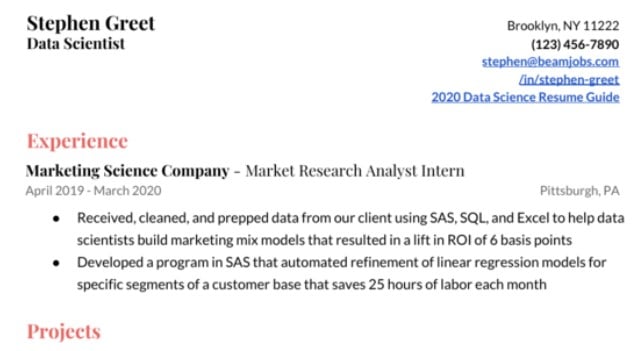
Why is this resume good?
- The career objective clearly states the candidate’s understanding of their skills and their needs
- The relevant courses section highlights knowledge they have gained in college
- The project section shows practical experience
Example 2
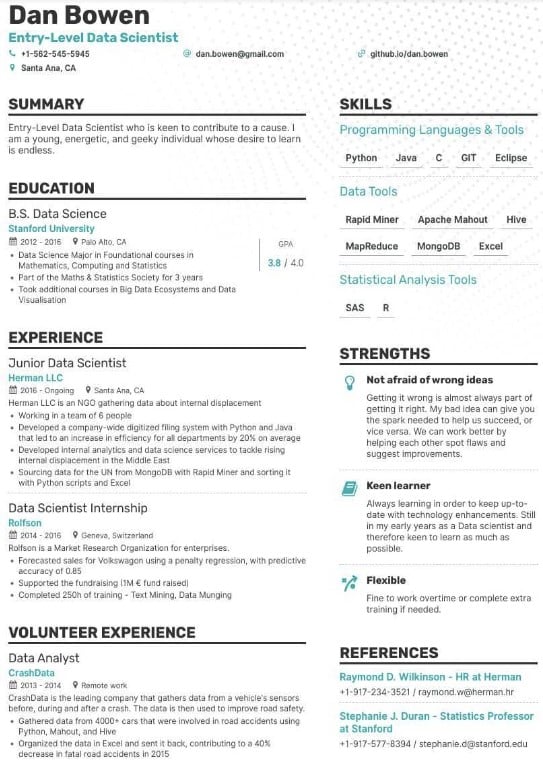
Why is this resume good?
- Summary is clear about experience and core skills
- Experience focuses on responsibilities, demonstrating business context understanding
- Skills section can be used to mirror the job description, making it easy for recruiters to make decisions
Senior Data Scientist Resume Examples
What To Include
As a senior data scientist with experience, you would be aiming for a position with more responsibility, like a data science manager, for example. This demands a customized and confident resume.
- Customize the resume for the job you’re applying to—highlight relevant skills/experience, mirror the job description
- Focus on responsibilities and accomplishments instead of tasks
- Include business outcomes you’ve produced with your work
- Present case studies of your key projects
Example 1
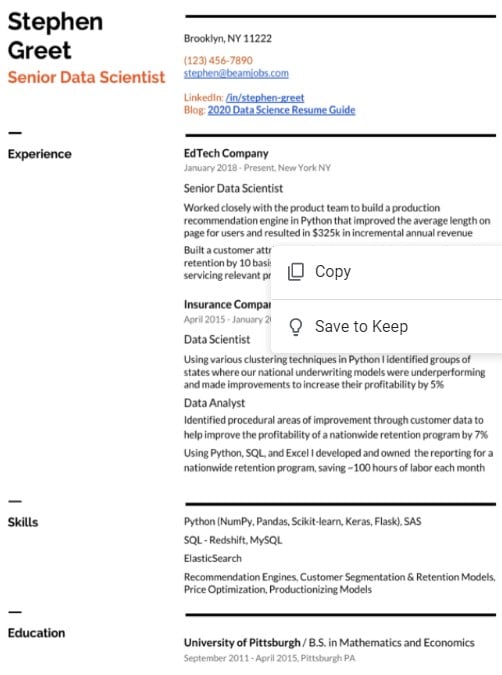
Why is this resume good?
- The information is organized in a clear and concise manner giving the entire view of the candidate’s career without overwhelming the reader
- Each job has quantifiable outcomes, demonstrating the business acumen of the candidate
- Also subtly hints at leadership skills by mentioning the responsibilities taken in coaching and leading teams
Example 2
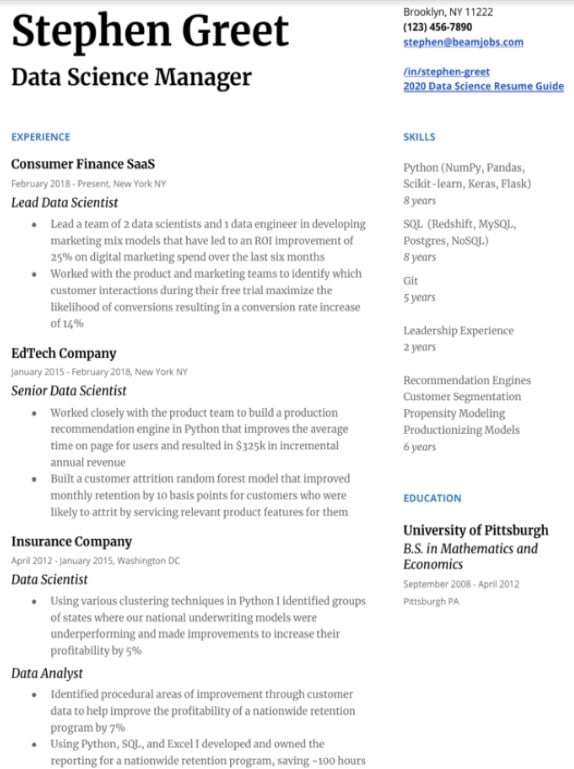
Why is this resume good?
- The focus of the resume is the experience section, outlining growth over seven years
- The resume shows a clear progression from the post of a junior data scientist to senior data scientist
- Links to LinkedIn, GitHub, Medium etc. show thought leadership
Other Data Science Designer Resume Examples We Love
Now that you’ve seen the basic set of resume examples, let’s explore a few others that might be equally effective. In this section, we’ve put together some non-traditional resumes and career paths for you to take inspiration from.
Example 1

Why is this resume good?
- For an entry-level data scientist position, the resume focuses on educational qualifications, certifications, etc.
- The projects section gives details about the goals, tasks, and tools used to demonstrate skills in practice
Example 2

Why is this resume good?
- Within data science, the candidate demonstrates specialized skills
- The work experience outlines the impact the candidate had created in the previous roles than focusing on the technical aspects of the model
- Experience section demonstrates career growth
Example 3
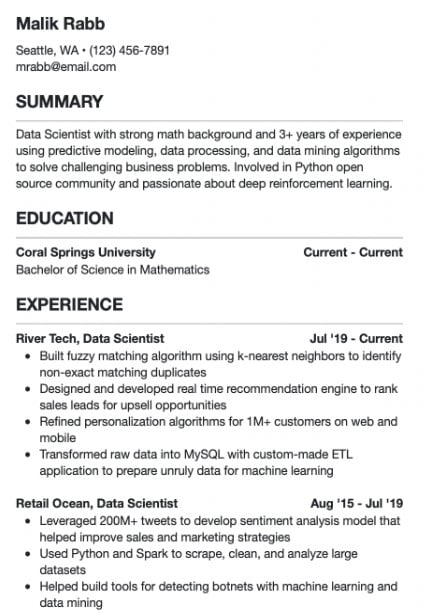
Why is this resume good?
- Profile is clear about the experience and the role the candidate is seeking
- Skills are listed clearly, making it easy to skim
- Certifications listed prominently
Tips for Creating an Awesome Data Science Resume
How To Stand Out
Do Your Research

Employers care less about you wanting a career in data science than they do about you wanting a career with them. “A tailored resume separates applicants who just want any job from those who want this job,” said Jon Brodsky, country manager for Finder.com. Before you start hacking together a data science resume, make sure you know who you’re sending the resume to.
Realistically, your resume won’t be wildly different for each application you file, but it should be somewhat different. The importance of this process is usually encapsulated in one word: fit. Are you a good fit for the company? Does your data science resume reflect the fact that you’re a good fit?
Read and re-read the job description. The job description is the most important piece of information to keep in mind. Your resume should demonstrate that you fill the job description: in experience, in skills, in location, etc.
Read the “About” page. So you found a position at a company and you know nothing about it? The best place to start is the “About” page or the page that gives an overview of the company, its mission, its values, etc.
Check out the company blog. If the company has a blog, read through it. This will give you a lot of detail about what it’s trying to do, who its target market is, the company voice, and much more.
Browse product pages and other site pages. Find out what the company is selling or doing. Make sure you’ve gotten a good birds-eye-view of the company, keeping in mind how you can help increase revenue from a data scientist’s point of view.
Scour the internet. Expand your search. Good external resources for learning what you might want to know include glassdoor.com, LinkedIn, and various media outlets that might have published articles and press releases related to the company.
Tip: This doesn’t have to take more than 30 minutes.
Choose a Good Template and Design
A well-designed resume is sure to catch the eye of a recruiter among the numerous ones they go through. But remember that just because a so-called “design resume” looks good doesn’t mean it is good or even effective.
You can select a pre-existing template, design your own, hire a professional graphic designer, and much more. Nonetheless, some experts would say that you’re overthinking it. “The format of the resume itself doesn’t matter, but it should be brief one-page maximum,” Brodsky said. “Hiring managers are busy and often inundated with resumes, so will only skim-read the first page anyway.”
Pick a resume design that employers can skim, not one they have to read. You don’t need fancy colors or logos on your resume. You don’t need a multimedia resume. You don’t need the best icons or visuals. However, if you use those, make sure they’re a reflection of you and not of a graphic designer you hired.
Organize Your Resume Layout
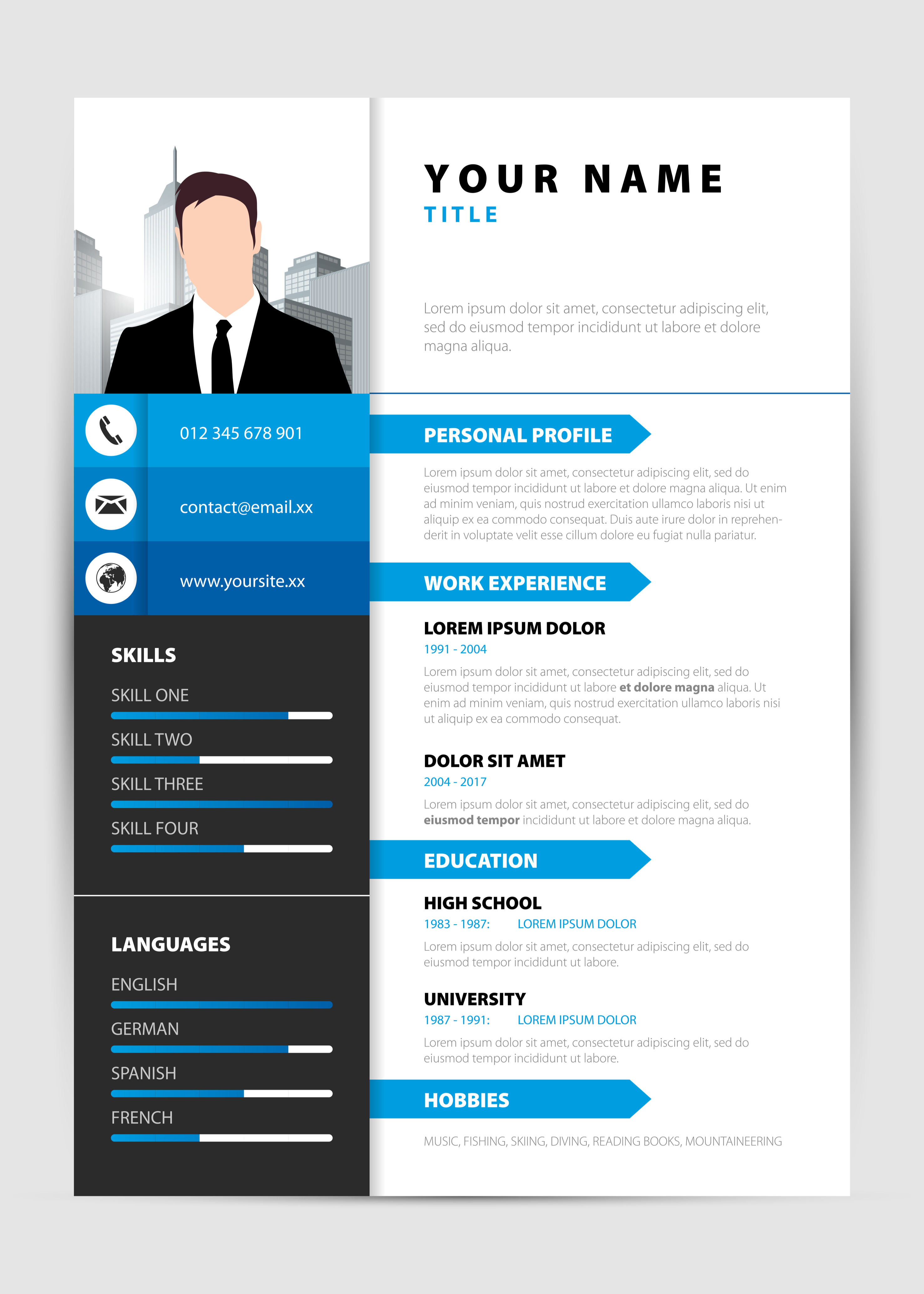
Given that recruiters decide on a candidate within seconds, it is crucial to provide them with all the necessary information at a glance. Here’s how you can do that.
- Use headings and subheadings for clear differentiation of information
- Highlight sections like ‘skills,’ ‘experience,’ ‘education’ etc. clearly
- Arrange experience in reverse chronological resume format with the most recent on top
- Give your relevant experiences take up the most space
- Make sure there is enough white space, avoid your resume looking cramped
Customize Your Resume
Circle back to your research: What makes you perfect for the role you are applying for? This is the question you should be answering in your resume.
- Mirror the resume—if you have skills that are mentioned in the job description, be sure to add it
- Write your resume in a way that’s suitable for the company culture. For instance, if you’re applying for a role at a self-driven startup, use language that shows you’re a good fit
What To Avoid

Since we just discussed the things to consider while crafting a resume, let’s also look at the things you need to avoid.
Too much information. Typically experienced professionals are tempted to include everything and its cousin into the resume. This can be counterproductive. Stick to the relevant information only.
Personal information. Your gender, race, marital status, sexual orientation, etc. is irrelevant to your job application. Do not include them. In fact, even photographs in resumes are illegal in several parts of the world.
Writing issues. Avoid spelling, grammar, and typography errors
Unprofessional language. While what’s professional has changed in the last few years, there are still boundaries. Don’t make your resume too colorful, stick to a neutral color palette. Use business language.
Mistakes and exaggerations. Don’t overstate your qualifications or accomplishments. Check that your contact information is up-to-date. Ensure all the links you’re providing work.
Where To Find Data Scientist Resume Templates

A quick Google search will produce millions of results. But that can be overwhelming. So, we’ve shortlisted a few for you.
Indeed
You can find sample resumes and templates on this website that will help you craft a functional resume.
365 Data Science
This website offers modern data science templates that strike a good balance between text and visual aesthetics.
Beamjobs
Whether you are an entry-level data scientist or someone with years of experience, you can find suitable resume samples and templates on their website.
Zety
Apart from resume samples and templates, their website also offers tips and examples on drafting an impressive data science resume.
Enhancv
With a complete guide on creating a compelling data science resume, this website offers templates and answers many common queries related to resume making.
Data Science Resume FAQs
Are Resume and CV the Same?
While a resume is short, consisting of only 1-2 pages, summarizing your professional experiences, a CV is a longer document that details the whole course of your career. However, today, most recruiters and hiring managers use them interchangeably. Unless the organization specifically asks for a detailed record of your career, you can safely assume that they mean resume.
Should You Customize Your Data Science CV for Each Job?
Yes, you should. When you send a generic resume, you burden the recruiter with the task of evaluating your suitability for the role. By customizing your resume, you clearly answer the question they have in mind. They will appreciate that.
How Long Should a Data Science Resume Be?
Hiring managers are busy. They prefer to see a clear and concise resume. The standard practice is a single-page resume. But certainly never go over two pages.
What Skills Should You Put On Your Data Scientist Design Resume?
Your resume should have the technical data scientist skills that your job description demands. To make this process easier, first list all your data science skills and then match them with the role you are applying for, starting with your strongest skill. Data scientists must list their expertise on their resumes. Some commonly sought-after skills include data analysis, data wrangling, data mining, data visualization, statistical analysis, machine learning, predictive analytics, and programming.
Since you’re here…Are you a future data scientist? Investigate with our free guide to what a data scientist actually does. When you’re ready to build a CV that will make hiring managers melt, join our Data Science Bootcamp that guarantees a job or your tuition back!





